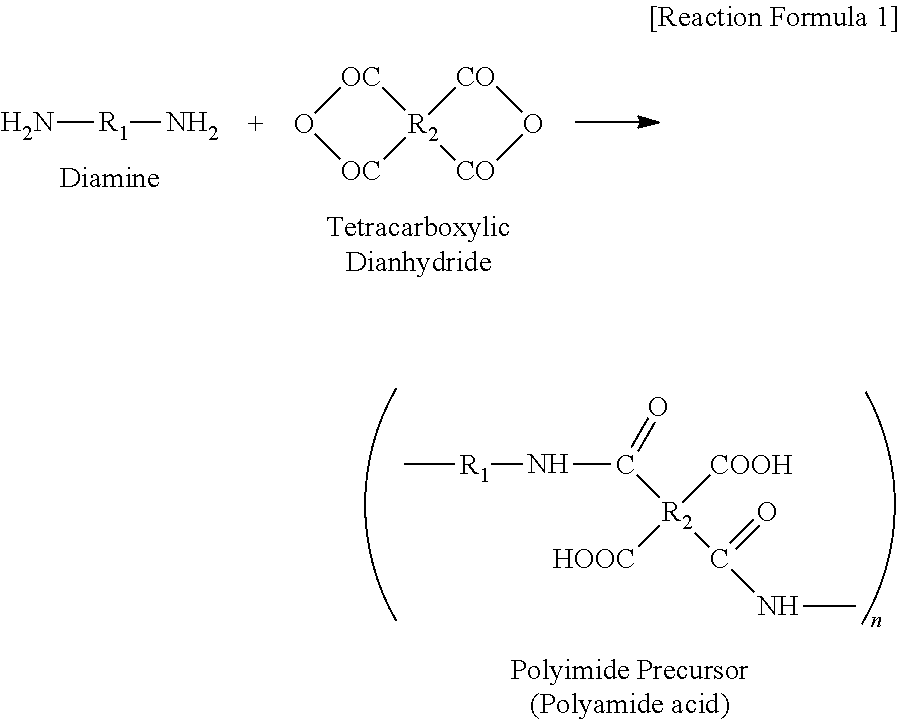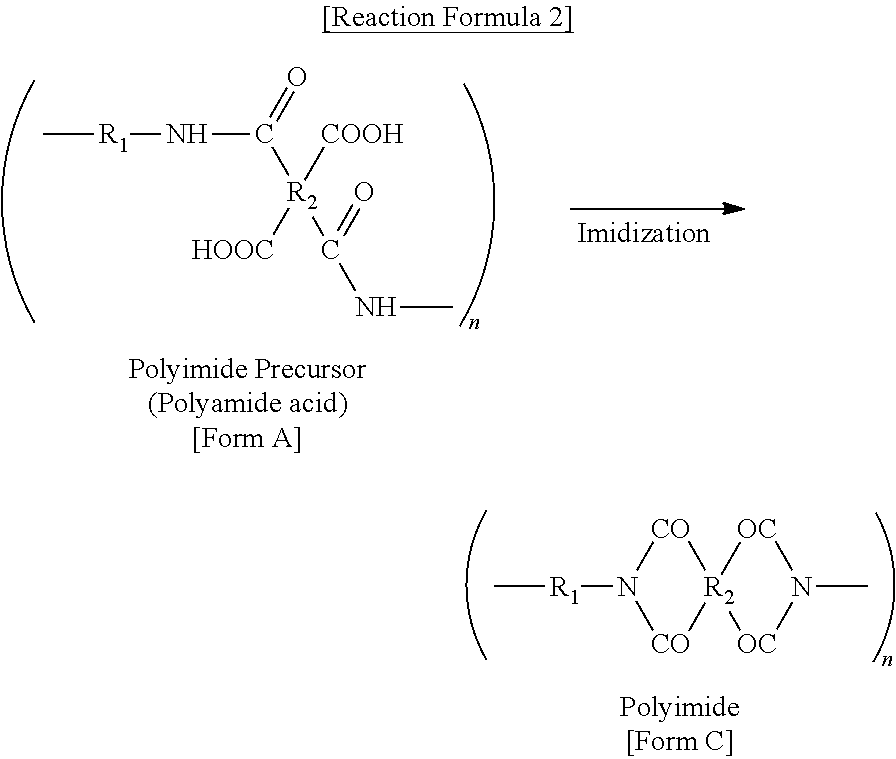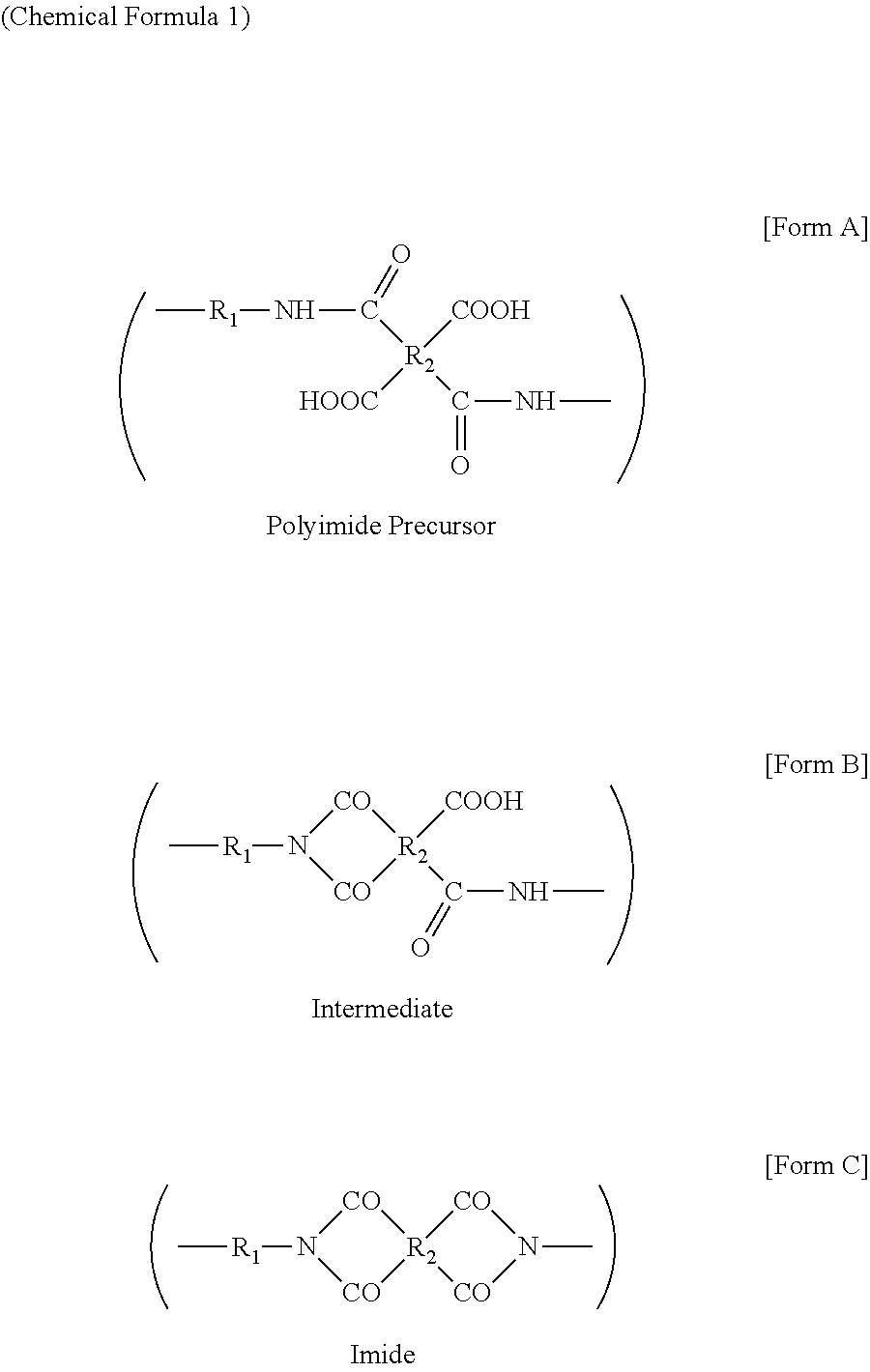Transparent electrode
- Summary
- Abstract
- Description
- Claims
- Application Information
AI Technical Summary
Benefits of technology
Problems solved by technology
Method used
Image
Examples
preparation example 1
[0046]A polyimide precursor solution (solid content: 20%) was prepared by polycondensing 2,2′-bis(trifluoromethyl)-4,4′-diaminobiphenyl (2,2′-TFDB) and biphenyltetracarboxylic dianhydride (BPDA) with 2,2-bis(3,4-dicarboxyphenyl)hexafluoropropane dianhydride (6-FDA) in dimethylacetamide using a commonly-used method. This reaction procedure is represented by Reaction Formula 1 below.
[0047]Subsequently, 2˜4 equivalents of acetic anhydride (Samjeon Chemical Co., Ltd.) and pyridine (Samjeon Chemical Co., Ltd.), serving as curing agents, were respectively added to 300 g of the polyimide precursor solution to form a polyamic acid solution. Then, the polyamic acid solution was heated at a heating rate of 1˜10° C. / min for 2˜10 hours to a temperature of 20˜180° C. to partially imidize (partially cure) the polyamic acid solution, thereby preparing a solution containing a partially-imidized (partially-cured) intermediate.
[0048]The following Reaction Formula 2 represents a reaction procedure use...
preparation example 2
[0057]34.1904 g of N,N-dimethylacetamide (DMAc) was charged in a 100 mL 3-neck round-bottom flask, as a reactor, provided with a stirrer, a nitrogen injector, a dropping funnel, a temperature controller and a cooler while passing nitrogen through the flask, and then the reactor is cooled to 0° C., and then 4.1051 g (0.01 mol) of 6-HMDA was dissolved in the N,N-dimethylacetamide (DMAc) to form a first solution, and then the first solution was maintained at 0° C. Subsequently, 4.4425 g (0.01 mol) of 6-FDA was added to the first solution to form a second solution, and then the second solution was stirred for 1 hour to completely dissolve 6-FDA in the second solution. In this case, the concentration of solid matter in the second solution was 20 wt %. Thereafter, this second solution was stirred for 8 hours at room temperature to obtain a polyamic acid solution having a viscosity of 2400 cps at 23° C.
[0058]After the reaction was completed, the obtained polyamic acid solution was applied ...
preparation example 3
[0059]Similar to in Preparation Example 2, 2.87357 g (0.007 mol) of 6-HMDA was dissolved in 32.2438 g of N,N-dimethylacetamide (DMAc) to form a first solution, and then 0.7449 g (0.003 mol) of 4-DDS was added to the first solution and then completely dissolved therein to form a second solution. Subsequently, 4.4425 g (0.01 mol) of 6-FDA was added to the second solution to form a third solution, and then the third solution was stirred for 1 hour to completely dissolve 6-FDA in the third solution. In this case, the concentration of solid matter in the third solution was 20 wt %. Thereafter, this third solution was stirred for 8 hours at room temperature to obtain a polyamic acid solution having a viscosity of 2300 cps at 23° C.
[0060]Thereafter, a polyimide film was prepared using the same method as in Preparation Example 2.
PUM
 Login to View More
Login to View More Abstract
Description
Claims
Application Information
 Login to View More
Login to View More - R&D
- Intellectual Property
- Life Sciences
- Materials
- Tech Scout
- Unparalleled Data Quality
- Higher Quality Content
- 60% Fewer Hallucinations
Browse by: Latest US Patents, China's latest patents, Technical Efficacy Thesaurus, Application Domain, Technology Topic, Popular Technical Reports.
© 2025 PatSnap. All rights reserved.Legal|Privacy policy|Modern Slavery Act Transparency Statement|Sitemap|About US| Contact US: help@patsnap.com



